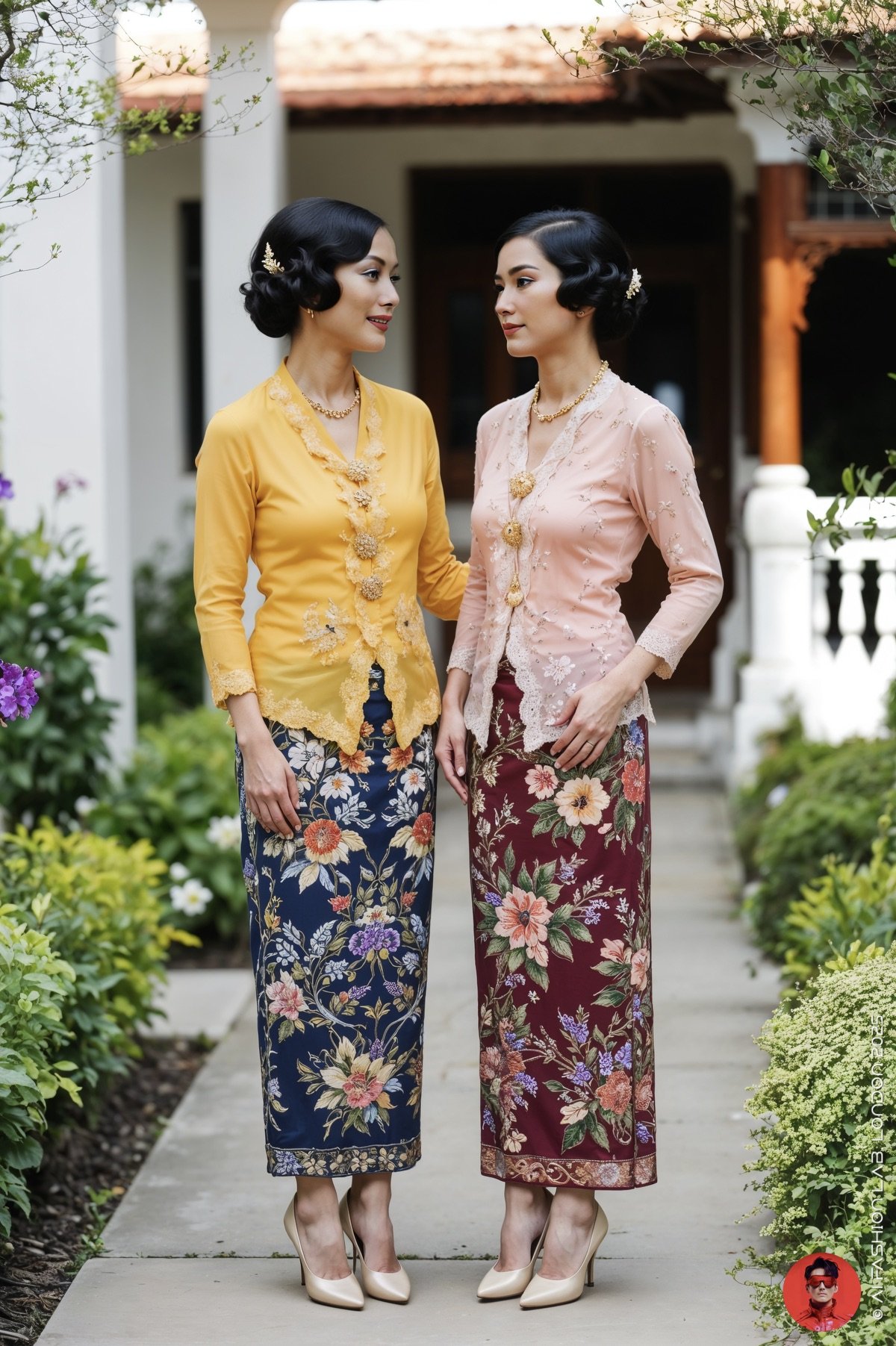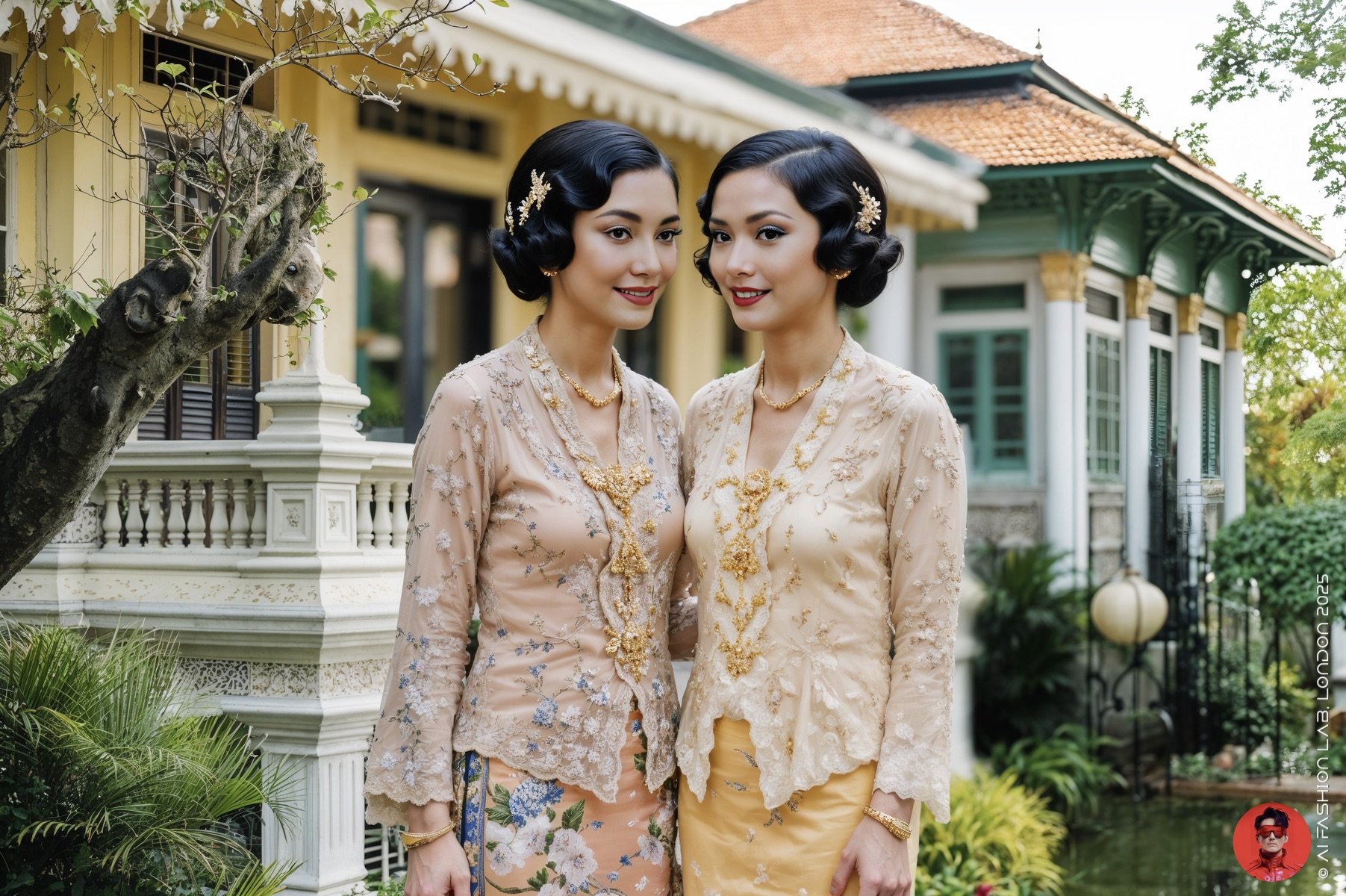เคบายาในฝัน: จินตนาการแฟชั่นภูเก็ตทศวรรษ 1930 ในสมัยรัชกาลที่ ๗
เคบายาในฝัน: จินตนาการแฟชั่นภูเก็ตทศวรรษ 1930 ในสมัยรัชกาลที่ ๗
เคบายา (Kebaya) หรือที่รู้จักในชื่อท้องถิ่นว่า “เสื้อย่าหยา” มิใช่เพียงเครื่องแต่งกาย หากแต่เป็นตัวแทนแห่งอัตลักษณ์ทางวัฒนธรรมที่ถ่ายทอดผ่านงานฝีมืออันประณีตและผืนผ้าที่มีชีวิต จุดกำเนิดของเครื่องแต่งกายชนิดนี้ฝังรากอยู่ในวิถีชีวิตของชุมชนบาบ๋า-ย่าหยาในจังหวัดชายฝั่งทะเลอันดามันของภาคใต้ อาทิ ภูเก็ต สตูล ตรัง กระบี่ พังงา และระนอง อีกทั้งยังมีสายใยเชื่อมโยงกับวัฒนธรรมเพอรานากันในมาเลเซียและสิงคโปร์
บทความนี้เป็นส่วนหนึ่งของคอลเลกชันภาพแฟชั่นที่สร้างสรรค์ด้วยเทคโนโลยี AI ซึ่งเป็นการสร้างสรรค์เกี่ยวกับแฟชั่นไทยในหลากหลายยุคสมัยและภูมิภาคทั่วประเทศ โดยเฉพาะคอลเลกชันนี้นับเป็นผลงานชุดที่สาม สืบเนื่องจากชุดก่อนหน้า ได้แก่ "แฟชั่นงานแต่งของชาวเพอรานากัน" และ "เคบายาในบริบทปัจจุบัน" สำหรับผลงานชุดนี้ เป็นการสดุดีความงามของวัฒนธรรมการแต่งกายในภาคใต้ของไทย ผ่านรูปแบบชุดเคบายาที่ได้รับแรงบันดาลใจจากแฟชั่นและซิลลูเอ็ตสมัยรัชกาลที่ ๗ ซึ่งเต็มไปด้วยกลิ่นอายวินเทจแห่งทศวรรษ 1930
คอลเลกชัน AI นี้เป็นจินตนาการร่วมสมัยของสไตล์แฟชั่นเคบายาสำหรับสตรีในภาคใต้ของไทย โดยเฉพาะในจังหวัดภูเก็ต ในช่วงทศวรรษ 1930 ซึ่งอยู่ในรัชสมัยพระบาทสมเด็จพระปกเกล้าเจ้าอยู่หัว (รัชกาลที่ 7) ผมได้ออกแบบทรงผมลอนคลื่น หรือ ทรงปันหยี (Finger Waves) ตามแบบฉบับแฟชั่นยุค 1930 รวมถึงจัดองค์ประกอบฉากหลังให้กลมกลืนกับสถาปัตยกรรมแบบ ชิโน-โปรตุกีส (Sino-Portuguese architecture) และ สถาปัตยกรรมแบบโคโลเนียล (Colonial architecture) ซึ่งถือเป็นเอกลักษณ์ของเมืองภูเก็ตอย่างแท้จริง คอลเลกชันนี้นำเสนอความงดงามแบบวินเทจ และมอบมิติใหม่ที่เปรียบเสมือนประตูสู่ประวัติศาสตร์แฟชั่นในยุคนั้น
รากเหง้าและการผสมผสานทางวัฒนธรรม
ชุดเคบายาในภาคใต้ของไทยมีต้นกำเนิดจากกลุ่มชาวจีนอพยพในช่วงปลายศตวรรษที่ 19 ที่สมรสกับหญิงพื้นเมืองชาวมลายู กลายเป็นกลุ่มชาติพันธุ์ใหม่ที่เรียกว่า บาบ๋า-ย่าหยา (Baba-Nyonya) ซึ่งมีวัฒนธรรมเป็นของตนเอง และแสดงออกผ่านเครื่องแต่งกายที่ผสมผสานเอกลักษณ์ของ จีน มาเลย์ และตะวันตก เข้าไว้ด้วยกันอย่างลงตัว
ลักษณะของชุดเคบายาแบบภาคใต้
เสื้อแขนยาว ผ่าอกแบบคอวี
ชายเสื้อหน้าปลายแหลม ด้านหลังสั้นระดับสะโพก
ใช้ เข็มกลัดโกสัง แทนกระดุมในการยึดสาบเสื้อ
ปักลวดลายมงคล เช่น ดอกไม้ เถาวัลย์ หรือสัตว์ในคติความเชื่อ
สวมคู่กับ ผ้าปาเต๊ะเขียนลายด้วยมือ จากรัฐเคดาห์หรือเกาะชวา
นิยมสวมใส่ในงานมงคล งานประเพณี หรืองานพิธีต่าง ๆ เพื่อแสดงฐานะ ความเป็นกุลสตรี และความภูมิใจในเชื้อสายบรรพบุรุษ
รูปแบบเคบายา 3 ประเภทดั้งเดิมในภาคใต้
เคบายาลันดา (Kebaya Renda) – เสื้อหลวม ใช้ผ้าป่านหรือผ้าหนา แต่งขอบเสื้อและแขนด้วยลูกไม้จากยุโรป
เคบายาบีกู (Kebaya Biku) – ใช้เทคนิคการปักฉลุลายด้วยเครื่องจักร ลายเรขาคณิต เถาวัลย์ หรือดอกไม้
เคบายาซูแลม (Kebaya Sulam) – เสื้อเข้ารูป ใช้ผ้ารูเปียร์เนื้อบาง ปักด้วยไหมจีนสีสดอย่างประณีต
การพัฒนาและการอนุรักษ์ในยุคปัจจุบัน
ปัจจุบันเคบายาได้รับการพัฒนาให้ร่วมสมัยมากขึ้น:
ใช้ผ้าคอตตอน ผ้าลินิน ผ้าออแกนซา แทนผ้าแบบดั้งเดิม
ปักลวดลายด้วยจักร หรือใช้ลูกไม้สำเร็จรูป
เสื้อเข้ารูปขึ้น เพื่อตอบสนองแฟชั่นร่วมสมัย
แม้จะเปลี่ยนแปลงไปตามกาลเวลา แต่ ชุดเคบายายังคงได้รับการฟื้นฟูในหลายพื้นที่ โดยเฉพาะในเทศกาลประจำปี พิธีแต่งงาน หรือกิจกรรมอนุรักษ์ท้องถิ่น บทบาทของเทคโนโลยี AI และแฟชั่นดิจิทัลเช่นคอลเลกชันนี้ ได้กลายเป็นส่วนหนึ่งของกระบวนการ สืบสานและตีความแฟชั่นดั้งเดิมในมิติใหม่
คอลเลกชันแฟชั่นนี้เป็นส่วนหนึ่งของความพยายามในการบันทึก ความงดงามของการแต่งกายไทยในหลากหลายภูมิภาคและยุคสมัย ผ่านภาพที่สร้างสรรค์ด้วย AI และการเล่าเรื่องทางวัฒนธรรม จุดประสงค์คือเพื่อให้ชุดเคบายายังคงอยู่ในความทรงจำ และเป็นแรงบันดาลใจสู่อนาคต
Kebaya Dreams: A 1930s Phuket Fashion Reimagined
Kebaya, known locally in Southern Thailand as seua ya-ya (เสื้อย่าหยา), is more than just a garment—it represents a cultural identity woven through meticulous craftsmanship and living textiles. The origins of this attire are deeply rooted in the lives of the Baba-Nyonya communities along the Andaman coastline of Southern Thailand, in provinces such as Phuket, Satun, Trang, Krabi, Phang Nga, and Ranong. The kebaya is also closely linked to the broader Peranakan cultural heritage found in Malaysia and Singapore.
This article is part of a fashion image collection created using AI technology. It is a creative exploration of Thai fashion across various periods and regions. This collection marks the third installment in a series, following earlier works on Peranakan wedding fashion and the kebaya in contemporary context. This time, the project pays homage to the elegance of traditional dress in Southern Thailand through a kebaya-inspired fashion narrative drawn from the reign of King Rama VII, infused with the vintage spirit of the 1930s.
This AI collection is a contemporary imagined interpretation of kebaya fashion for women in Southern Thailand, particularly in Phuket during the 1930s, under the reign of King Prajadhipok (Rama VII). I designed the hairstyles in the iconic 1930s finger wave style—locally referred to as banyee—and composed the visual settings to harmonise with the distinctive Sino-Portuguese and colonial architecture that defines the old town of Phuket. The result is a collection rich in vintage charm, offering a portal into the fashion history of the era.
Roots and Cultural Fusion
The Southern Thai kebaya traces its origins to the late 19th century, when Chinese immigrants married local Malay women, forming a new ethnic community known as Baba-Nyonya. This group cultivated a distinct hybrid culture, reflected most strikingly in their attire, which seamlessly blends Chinese, Malay, and Western influences.
Characteristics of the Southern Thai Kebaya
Long-sleeved blouse with a deep V-neckline
Tapered front hem ending in elegant points; shorter back at hip level
Traditionally fastened with kerongsang (a set of decorative brooches) instead of buttons
Embellished with auspicious motifs, such as flowers, vines, or mythical creatures
Worn with hand-drawn batik sarongs from Kedah or Java
The kebaya is often worn on auspicious occasions, traditional festivals, or ceremonial events to express femininity, social status, and pride in ancestral heritage.
Three Traditional Styles of Kebaya in Southern Thailand
Kebaya Renda – A loose-fitting blouse made from voile or heavier fabrics, edged with European lace trim
Kebaya Biku – Features machine-embroidered cutwork patterns, often geometric, floral, or vine-like
Kebaya Sulam – A form-fitting blouse crafted from fine rubia fabric, intricately embroidered with vibrant Chinese silk threads
Modern Development and Preservation
Today, the kebaya has been adapted into more contemporary forms:
Substitution of traditional fabrics with cotton, linen, or organza
Embroidery done by machine or replaced with pre-made lace
More tailored silhouettes to meet modern fashion preferences
Despite these changes, the kebaya continues to be revived in many areas, especially during annual festivals, weddings, and local heritage events. AI and digital fashion, such as in this collection, now play a vital role in preserving and reinterpreting traditional fashion through new lenses.
This fashion collection is part of a broader effort to document the beauty of Thai dress across regions and historical periods. By combining AI-generated imagery with cultural storytelling, the aim is to keep the kebaya alive in collective memory—and to inspire its evolution into the future.
#aifashionlab #AI #aiartist #aiart #aifashion #aifashiondesign #aifashionstyling #aifashiondesigner #fashion #fashionhistory #historyoffashion #fashionstyling #fashionphotography #digitalfashion #digitalfashiondesign #digitalcostumedesign #digitaldesign #digitalaiart #ThaiFashionHistory #ThaiFashionAI #flux #fluxlora #fluxkontext








































